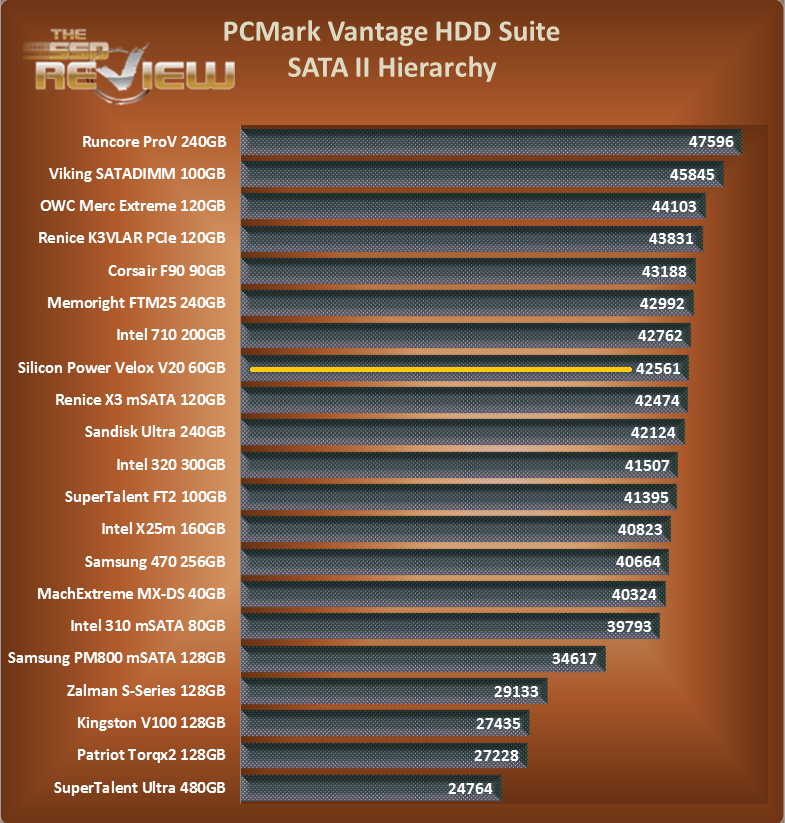The SSD Review uses benchmark software called PCMark Vantage x64 HDD Suite to create testing scenarios that might be used in the typical user experience. There are eight tests in all and the tests performed record the speed of data movement in MB/s to which they are then given a numerical score after all of the tests are complete. The simulations are as follows:
- Windows Defender In Use
- Streaming Data from storage in games such as Alan Wake which allows for massive worlds and riveting non-stop action
- Importing digital photos into Windows Photo Gallery
- Starting the Vista Operating System
- Home Video editing with Movie Maker which can be very time consuming
- Media Center which can handle video recording, time shifting and streaming from Windows media center to an extender such as XBox
- Cataloging a music library
- Starting applications
If you are new to testing and considering benchmark software, this is the best you can get because the program goes well beyond the results of simulated testing as we have already done. In comparing SATA 2.0 SSDs, we have reached the bandwidth limit and the performance of most new SATA 2 SSDs is as high as it can get with typical high sequential access speeds in the area of 280MB/s read and 270MB/s write.
We needed a way to differentiate these drives and to find a method that can actually put one drive above another and this is exactly what Vantage testing does. Its tests combined can provide an accurate comparison between drives and its tests individually can assist a smart shopper in finding the best SSD for their needs. Next to actual true to life testing which can take an insurmountable length of time, PCMark Vantage is the only program that can compare any SSD, side by side, regardless of SATA interface or controller in use.
SILICON POWER VELOX V20 VANTAGE TOTAL POINT SCORE
The V20 pulled through Vantage testing with a high of 42561 points and a single test high of speed of 237MB/s while testing in Media Player. This is actually a very good score and surprised me. Lets take a look where it stands amongst all other SATA 2 SSDs:
The Silicon Power V20 performed well in its synthetic tests and surprised the heck out of us in its PCMark Vantage result. This would appear to tell us that this would be an ideal drive for a typical PC user who simply surfs the net, sends e-mails and uses typical application software.
Having said that, I simply cannot overlook the results seen in testing incompressible data which are half of the average result of other SSDs tested. The Sandisk Ultra was used and linked as an example. Infact, I didn’t even expect to test with AS SSD but it became a necessity with the initial Crystal Disk Mark result while testing with random or incompressible data. We carried this even further by demonstrating how this would like in a real life scenario while transferring games, programs or an ISO file.
It then brings me back to the NAND in use when I noticed that their higher capacities are housed with the standard Intel NAND flash memory rather than Hynix, a brand which we haven’t seen previously in any solid state drives. Perhaps that accounts for this low result.
All in all, we cannot recommend the Silicon Power Velox V20 as a typical consumer product. I invite response from Silicon Power if they believe we may have erred in some way and also invite their submission of their newer SATA III release for review.
Have an opinion? Something to say? TAKE IT TO THE THREADS!
 The SSD Review The Worlds Dedicated SSD Education and Review Resource |
The SSD Review The Worlds Dedicated SSD Education and Review Resource | 


these are 32nm NAND chips. We are yet to see 26nm Hynix NAND, with 64gbits chips, NAND prices need more competiors.
Can’t wait for 15nm NAND that Hynis promised for 2012
Yes it states 32nm chips. Tx for the input!
The version of the Silicon Power Velox V20 60GB reviewed here looks very different then the versions being sold currently. Is this an older version? I have also located versions with a different marking that includes a serial number. That version uses a Micron memory device. Any ideas what gives here?
That review was done in 2011 so, most sedfinitely, they may have gone with a different run of internal components.